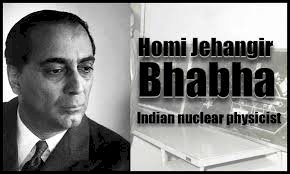Homi J. Bhabha | The Father of India’s Nuclear Program
Dr. Homi Jehangir Bhabha is celebrated as the Father of India’s Nuclear Program, a visionary scientist who laid the foundation for the country's atomic energy initiatives. Under his leadership, India made significant strides in nuclear science, placing it on the global map as a power in peaceful nuclear energy applications.
Homi J. Bhabha: The Father of India’s Nuclear Program
Quick Facts about Homi J. Bhabha
| Attribute | Details |
|---|---|
| Full Name | Homi Jehangir Bhabha |
| Date of Birth | October 30, 1909 |
| Place of Birth | Bombay (now Mumbai), Maharashtra, India |
| Date of Death | January 24, 1966 |
| Age at Death | 56 years |
| Profession | Nuclear Physicist, Visionary, Academic |
| Known For | Establishing India’s nuclear program, Founding TIFR and AEET (now BARC) |
| Education | University of Cambridge (Mechanical Engineering, PhD in Theoretical Physics) |
| Major Contributions | Development of atomic energy in India, Establishment of India’s nuclear research ecosystem |
| Awards | Adams Prize (1942), Padma Bhushan (1954) |
| Net Worth (Historical) | Not applicable; worked primarily in scientific and public service |
Introduction
Dr. Homi Jehangir Bhabha is celebrated as the Father of India’s Nuclear Program, a visionary scientist who laid the foundation for the country's atomic energy initiatives. Under his leadership, India made significant strides in nuclear science, placing it on the global map as a power in peaceful nuclear energy applications. His life, tragically cut short in an air crash, remains a beacon of inspiration for aspiring scientists and innovators.
This blog explores Bhabha’s life, achievements, and enduring legacy in shaping modern India's scientific and technological landscape.
Early Life and Education
Homi J. Bhabha was born on October 30, 1909, in Bombay, into a wealthy and influential Parsi family. His father, Jehangir Bhabha, was a prominent lawyer, and his mother, Meherbai, was a social activist. Bhabha showed an early aptitude for mathematics and science, excelling academically throughout his schooling.
After completing his education in India, Bhabha traveled to England to study Mechanical Engineering at the prestigious University of Cambridge, as per his family’s wishes. However, his passion for theoretical physics soon led him to switch disciplines. He completed his PhD in Theoretical Physics in 1935 under the guidance of renowned physicist Paul Dirac, contributing significantly to quantum mechanics and cosmic ray research.
Scientific Career and Contributions
1. Cosmic Ray Research
Homi Bhabha’s early work focused on cosmic rays and quantum theory, earning him recognition in the global scientific community. His Bhabha Scattering theory, which describes electron-positron scattering, became a fundamental contribution to particle physics.
2. Foundation of TIFR
Recognizing the need for advanced research facilities in India, Bhabha established the Tata Institute of Fundamental Research (TIFR) in 1945 in Mumbai. Funded by the Tata Trusts, TIFR became the cornerstone of India’s research in nuclear science, mathematics, and astrophysics.
3. Setting Up AEET (BARC)
In 1954, Bhabha founded the Atomic Energy Establishment, Trombay (AEET), which was later renamed the Bhabha Atomic Research Centre (BARC) in his honor. AEET became the hub for nuclear research and reactor development in India.
4. India’s Nuclear Program
Bhabha spearheaded India’s peaceful nuclear program, emphasizing the use of atomic energy for power generation, agriculture, and medicine. Under his leadership, India developed the Apsara reactor in 1956, Asia’s first nuclear reactor.
5. Advocate for Peaceful Nuclear Use
Bhabha was a strong proponent of using nuclear energy for peaceful purposes. At the International Atomic Energy Agency (IAEA) and United Nations forums, he advocated for the equitable use of nuclear technology worldwide.
Awards and Recognition
Dr. Homi Bhabha’s groundbreaking contributions earned him numerous accolades:
- Adams Prize (1942): For his work on cosmic radiation.
- Padma Bhushan (1954): One of India’s highest civilian awards for his contributions to science.
- Fellow of the Royal Society of London (FRS): A prestigious recognition of his scientific achievements.
Personal Life
Homi J. Bhabha never married, dedicating his life entirely to science and national development. Known for his charisma and love for art, Bhabha was an avid painter and patron of classical music.
Tragic Death
Dr. Bhabha’s life ended tragically on January 24, 1966, in an air crash near Mont Blanc, Switzerland. He was on his way to attend a meeting of the International Atomic Energy Agency (IAEA) in Vienna. The circumstances surrounding the crash have been a topic of speculation, with some theories suggesting sabotage. However, no conclusive evidence supports these claims.
Legacy
Homi J. Bhabha’s vision and leadership laid the groundwork for India’s advancements in science and technology. His legacy is preserved through institutions like TIFR and BARC, which continue to play pivotal roles in India’s nuclear and scientific research.
Key Contributions to Modern India:
- Establishing India’s nuclear research infrastructure.
- Promoting self-reliance in scientific and technological development.
- Inspiring generations of scientists through his pioneering work.
Today, India’s achievements in nuclear power, space exploration, and advanced scientific research owe much to the foundation laid by Bhabha.
Conclusion
Dr. Homi J. Bhabha’s life was a testament to the transformative power of science. His vision of harnessing atomic energy for development, combined with his dedication to research and innovation, continues to inspire scientists and researchers globally.
As we remember him, we honor not only his contributions to nuclear science but also his role in shaping a modern, self-reliant India.
References
- BARC Official Website
- TIFR Official Website
- Britannica – Homi J. Bhabha Biography
- International Atomic Energy Agency (IAEA)
This comprehensive blog captures the essence of Homi J. Bhabha’s life, achievements, and the enduring legacy he left behind.

 Deepak Maurya
Deepak Maurya 
































